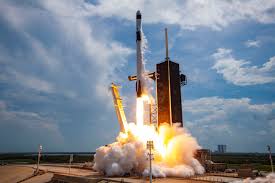Introduction to Spacex
Spacex Launch, or Space Exploration Technologies Corp., was founded in 2002 by Elon Musk with a bold vision: to reduce space transportation costs and colonize Mars. This revolutionary aerospace manufacturer and space transportation company has taken incredible steps, challenging traditional models and pushing boundaries in the space industry. SpaceX is one of the few private companies to have launched, orbited, and returned spacecraft safely, setting new standards for the private sector’s capabilities in space exploration.

Significance of Spacex Launch
Spacex launch capabilities have redefined what private companies can achieve in space. As the first private company to send spacecraft to the International Space Station (ISS), Spacex has proven that private entities can partner with governments and redefine space exploration. By lowering costs and introducing reusability, SpaceX has made space more accessible to private and public organizations, sparking a new era of commercial space exploration.
Spacex Mission and Vision
At its core, Spacex Launch aims to make life multi-planetary. The company’s ambitious goals include unprecedentedly reducing the cost of space travel and eventually establishing a human settlement on Mars. Spacex envisions a future where interplanetary travel becomes routine, allowing humankind to explore beyond Earth.
Falcon Rocket: The Game-Changer
Spacex Launch Falcon rocket series has been central to the company’s success. The company’s first launch vehicle, the Falcon 1, marked Spacex’s entry into space. After that, the Falcon 9 and Falcon Heavy were introduced, both known for their reusability and significant lifting capabilities, which changed the aerospace industry’s approach to rocket design and operations.
Falcon 9: A Closer Look
The Falcon 9 rocket has become a staple in modern spacex launch due to its reliability and efficiency. Powered by nine Merlin engines, the rocket is fully reusable, making it cost-effective and environmentally friendly. The Falcon 9’s reusability not only saves production costs but also allows for frequent launches, which is important for both Spacex and its customers.
Falcon Heavy: Breaking the Limits
The Falcon Heavy, the world’s most powerful operational rocket, has pushed the limits of what a rocket can do. With a liftoff capacity of nearly 64 metric tons, the Falcon Heavy has opened up new possibilities for deep Spacex Launch missions, satellite deployment and heavy cargo transport. Each launch demonstrates SpaceX’s engineering prowess, further cementing its reputation as an industry leader.
Starship: Spacex Launch Visionary Vehicle
Starship, Spacex Launch latest project, is designed to make interplanetary travel possible. Unlike previous rockets, Starship is a fully reusable spacecraft capable of carrying humans to Mars and beyond. Equipped with advanced Raptor engines, Starship aims to significantly reduce the cost of space travel and allow for large-scale human missions, beginning a new chapter in space exploration.
Reusability: The Key to Cost Reduction
One of Spacex Launch most notable achievements is its pioneering use of reusable rockets. Traditional rockets are single-use, leading to high costs per launch. By making rockets like the Falcon 9 and Starship reusable, SpaceX has significantly reduced costs, enabling more frequent and affordable access to space.
How Spacex launches benefit other industries
SpaceX doesn’t just promote space exploration; it also provides essential services to many industries. The company offers launch services for telecommunications, Earth observation, and even scientific research. With more affordable launches, industries around the world can now put satellites into orbit more cost-effectively, increasing global connectivity and access to data.
Spacex Launch Role in NASA Mission
NASA and SpaceX have established a strong partnership, with SpaceX being a key player in NASA’s Commercial Crew and Commercial Cargo programs. This collaboration has allowed NASA to once again send astronauts to the ISS on a U.S.-built rocket, a major accomplishment for both NASA and Spacex launch.
Challenges and Risks in Spacex Launches
Like any new venture, SpaceX has faced many challenges and risks. From early rocket failures to complex regulatory , SpaceX has had to deal with many obstacles. However, these challenges have only strengthened the company’s resolve, leading to innovations that are shaping the aerospace industry.
Spacex impact on global space policies
SpaceX’s success has prompted a reevaluation of space policies around the world. As more private companies enter the space industry, governments and international bodies are rethinking policies to encourage innovation and support commercial space ventures while maintaining safety and sustainability standards.
Future plans and projects for SpaceX
Looking ahead, SpaceX has ambitious plans, including establishing a human base on Mars, further developing the Starship system, and continuing partnerships with NASA and other entities. The company’s roadmap for the next decade includes more frequent and larger-scale missions, which could ultimately bring space exploration within reach for future generations.
Economic impact of SpaceX launches
SpaceX has made significant contributions to the economy by creating jobs, stimulating technological advancements, and inspiring new industries. The “SpaceX effect” has catalyzed growth in the aerospace sector and encouraged other companies to innovate, creating a ripple effect that benefits local and global economies.
Conclusion
SpaceX has revolutionized space exploration, transforming it from an expensive, government-only affair into a dynamic, accessible industry that is open to private companies and other countries. Its pioneering technologies, such as reusable rockets and advanced spacecraft, have set new standards in the aerospace industry, paving the way for a future where interplanetary travel is possible. As SpaceX continues its journey, the possibilities for exploration, discovery, and human advancement are truly limitless.
FAQs
1. What makes SpaceX’s rockets different from others?
SpaceX’s rockets are designed to be reusable, which significantly reduces launch costs and makes frequent launches possible.
2. How does SpaceX plan to colonize Mars?
SpaceX aims to use its Starship spacecraft for interplanetary missions, potentially establishing a human settlement on Mars.
3. How has SpaceX impacted the economy?
SpaceX has created jobs, driven technological advancements, and inspired growth in the commercial space industry, benefiting both local and global economies.
4. Why are private companies like SpaceX important in space exploration?
Private companies bring innovation, cost reductions, and increased accessibility to space, complementing the efforts of government agencies like NASA.
5. What are SpaceX’s future plans?
SpaceX’s future goals include continued development of the Starship system, more frequent missions, and eventually, a human presence on Mars.
Also Read :











